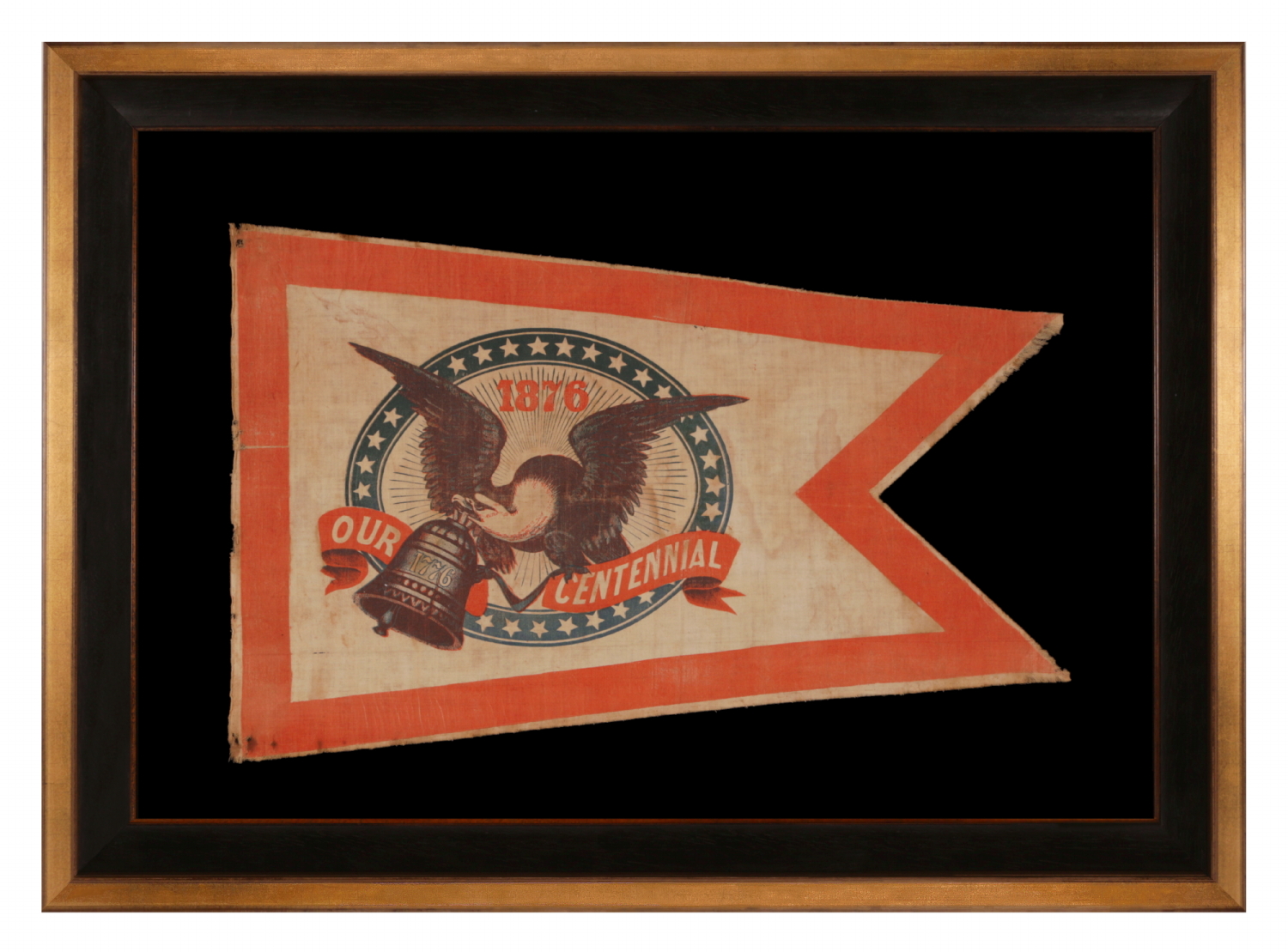


| SWALLOW-TAILED PARADE FLAG PENNANT / BANNER, WITH A BOLD ILLUSTRATION OF AN EAGLE CARRYING THE LIBERTY BELL, MADE TO CELEBRATE THE 1876 CENTENNIAL OF AMERICAN INDEPENDENCE; THE ONLY KNOWN EXAMPLE OF ITS KIND |
|
| Web ID: | pat-832 |
| Available: | In Stock |
| Frame Size (H x L): | 23.25" x 31.5" |
| Flag Size (H x L): | 14.25" x 20.5" |
| Description: | |
| Early American parade flag pennant / banner, printed on cotton, with a tapered, swallow tail format and a vibrant, red-orange border. In the center, block-printed in red, blue, and brown pigment, is the image of an American eagle, perched on a billowing streamer, emblazoned with the words “Our Centennial.” The eagle emerges from an oval window, blue with white stars, with rays of sunshine bursting forth and the date “1876” above. The oval format is actually purposeful, although it may not seem so to the casual observer. Present in other centennial imagery and objects, it represents an egg, metaphorically illustrating the nation’s birth. Oval, from the Latin “ovum”, symbolizing eternity / unity / new beginnings. Held in the eagle’s beak is an artistically incorrect, though beautiful, representation of the Liberty Bell, with “1776” across the center. Numerous types of parade flag style pennants were produced in celebration of America’s 100th anniversary of independence. Though I have been buying, collecting, selling, and observing them for decades, I have not before encountered this bold and beautiful variety. The election to show the Liberty Bell is notable in 1876 specifically, when this icon of American freedom was brought for the from Independence Hall. First cracked during its initial testing in 1752, with its larger and most famous, irreparable crack suffered sometime during the early 1840’s, it had been displayed on the hall’s second floor for about a quarter century. In conjunction with its removal, the much larger “Centennial Bell,” made in part from four cannons, one American and one British, from the Revolutionary War Battle of Saratoga, plus one Union and one Confederate, from the Civil War Battle of Gettysburg, was installed that year in the tower of Independence Hall, to ring in the festivities of July 4th. Made to be tacked to a staff, to be waved or otherwise displayed at parades or political events, this basic type of parade flag-type textile is known to have been produced by numerous makers. Designed in various forms, some horizontal and some vertical, those made for the centennial specifically are very scarce. Most are so rare that they survive as either one-of-one or one-of-two or three among known examples. Similar designs were available from various flag-makers throughout the latter 19th century and the beginning of the 20th, who readily copied one-another to compete for the same clientele of political, fraternal, and veteran’s organizations, World’s Fairs, and all manner of patriotic events. Some had rectangular profiles, some had straight sides with swallowtails, some were tapered and swallowtailed, like this example. Others were triangular. They were usually available with an array of standardized imagery. In addition to dates, anniversaries, events, and holidays, they included presidential portraits, generals, names of fraternal groups and organizations, fire companies, Civil War corps badges, and a myriad of state seals. Templates with starred borders could be special-ordered with whatever one desired. Mounting: For 25 years we have maintained our own textile conservation department, led by expert staff. We take great care in the mounting and preservation of flags and related textiles and have preserved thousands of examples. The two-part frame consists of a scooped molding with a woodgrain surface, walnut in color, with a rust-orange, beaded edge, to which a shadowbox style molding, with a distressed gold face and dark brown exterior—almost black—was added as a cap. The background is 100% cotton twill, black in color, that has been washed and treated for colorfastness. Spacers keep the textile away from the glazing, which is U.V. protective glass. Condition: There is some fading of the red-orange pigment and there is minor to moderate soiling of the white regions. There is a partial, lateral tear below the bell, toward the hoist end, and there are small tack holes along the lead edge, with associated rust stains, from where the flag was once affixed to its original wooden staff. There are nicks and some fraying along the perimeter. Many of my clients prefer early flags to show their age and history of use. |
|
| Video: | |
| Collector Level: | Advanced Collectors and the Person with Everything |
| Flag Type: | Parade flag |
| Star Count: | |
| Earliest Date of Origin: | 1876 |
| Latest Date of Origin: | 1876 |
| State/Affiliation: | Pennsylvania |
| War Association: | |
| Price: | Please call (717) 676-0545 or (717) 502-1281 |
| E-mail: | info@jeffbridgman.com |
 |
|